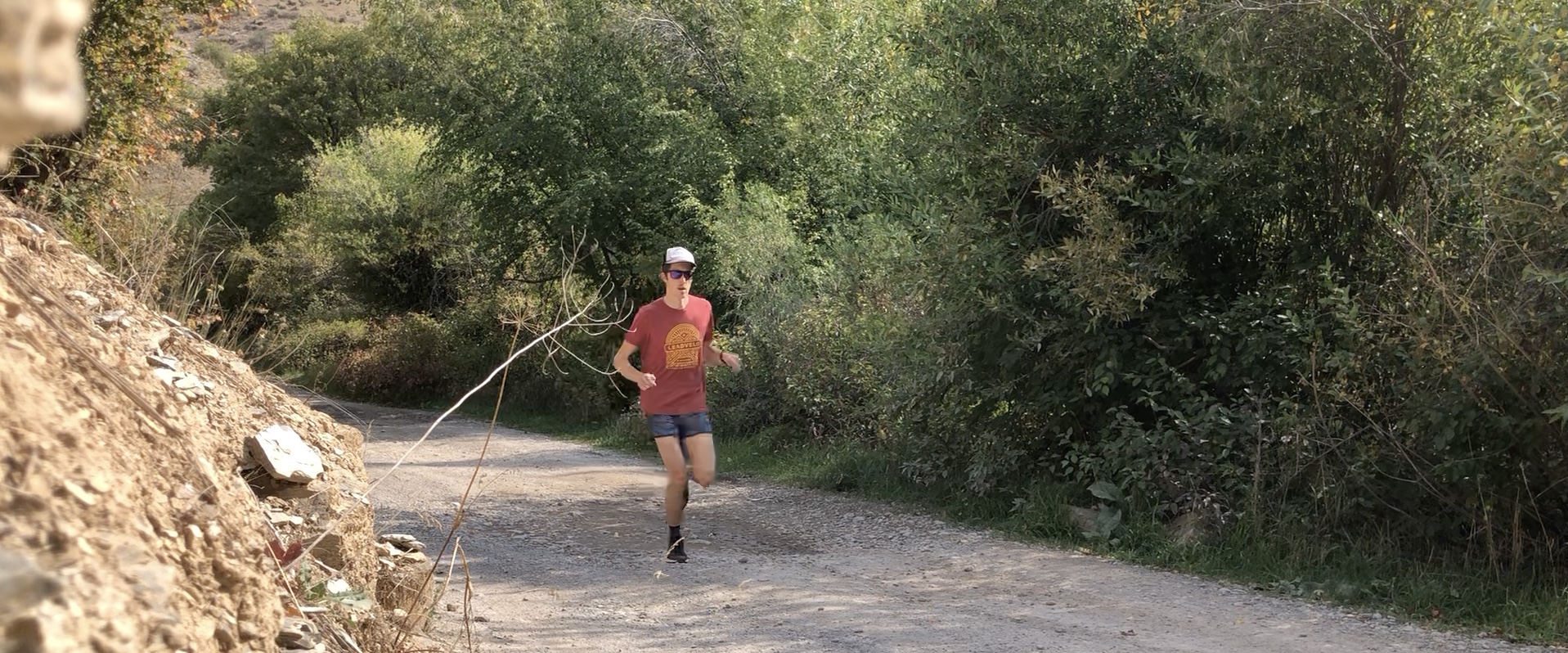adidas Terrex Two Ultra
Test Locations: Logan, Utah
Test Duration: 65 miles
Stated Stack Height (Midsole + Outsole): 29 mm (heel) / 23 mm (forefoot)
Stated Heel-to-Toe Drop: 6 mm
Stated Features:
- adidas PRIMEKNIT upper
- Sock-like fit
- BOOST midsole
- Abrasion resistant weldings
- Continental™ Rubber outsole
- Yarn in upper contains at least 50% Parley Ocean Plastic and 50% recycled polyester
MSRP: $180
Size Tested: US Men’s 11.5
Stated Weight per Shoe (US Men’s Size 9): 320 g / 11.3 oz
Blister Measured Weight per Shoe (US Men’s Size 11.5):
- Shoes + Laces: 346 g (left) & 347 g (right)
- Insoles: 21 g (left) & 20 g (right)
- Total: 367 g (left) & 367 g (right)
Reviewer: 6’1”, 145 lbs / 185 cm, 67 kg
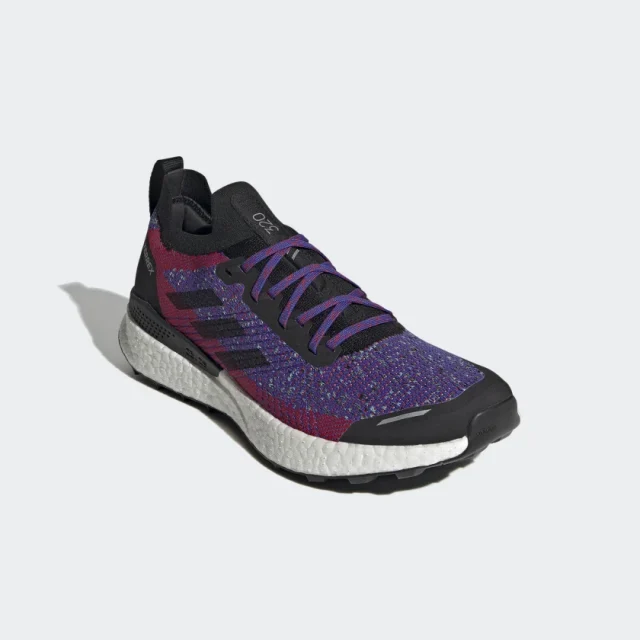
Intro
I think adidas’ Terrex line of trail running shoes has one of the most impressive trajectories of just about any trail running brand over the last couple of years. While I wasn’t overly impressed by their first couple of attempts at trail shoes, some of adidas’ more recent models have been among the best shoes I’ve tested this year. I’m also impressed by the brand’s commitment to sustainability — many of their shoes use dye-free colorways and / or recycled plastics to reduce their environmental footprint (Yeah, I know buying shoes still isn’t great for the environment even if they are using recycled materials, but hey, it’s still good to see brands like adidas making an effort).
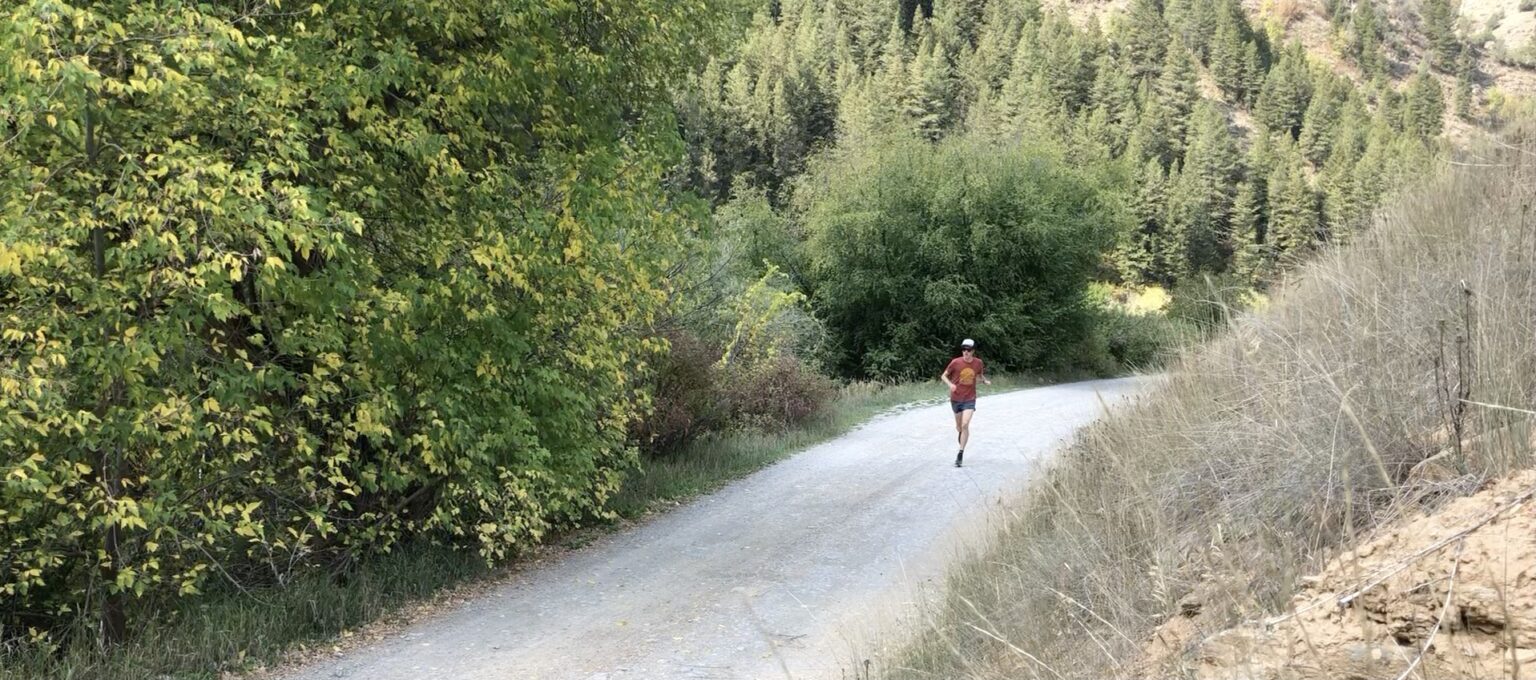
So with all that in mind, I was pretty excited to try out the adidas Terrex Two Ultra, which they claim is designed to “move fast and keep you comfortable on long trail runs.” I’m into both of those things, so I was curious to see how the Terrex Two Ultra would perform out on the trail. As an added bonus, the shoe’s upper also uses yarn derived from recycled ocean plastic — so bonus points to adidas for that.
After my first 65 miles in the Terrex Two Ultra, I think it has a lot going for it — but it also has a couple of quirks that have kept it from becoming my go-to shoe for long trail runs. Still, for the right person and in the right setting, I think it’s a pretty solid shoe. In this review, I’ll break down what that ideal setting / runner looks like, and also discuss some of the improvements that I think adidas could make to the Terrex Two Ultra.
Fit
As always, it’s best to try on the Terrex Two Ultra in person if you’re able. With that in mind, I’ll provide an overview of how the shoe fits my fairly narrow, low-volume feet. For reference, I’m generally a fan of shoes with snug-fitting midfoots and some space in the toe box for my toes to spread out.
First off, the Terrex Two Ultra seems to have some sizing inconsistencies both compared to shoes from other brands and other adidas shoes. I wear a US Men’s 11.5 in shoes from brands like Hoka and Altra, and I’ve also been happy with the fit of other adidas shoes (e.g. adidas Terrex Speed Ultra) in my usual 11.5. But the Terrex Two Ultra feels like it’s easily a half (and maybe even a full) size too big in an 11.5. The whole shoe feels a bit too roomy, and there’s quite a bit of extra length in the front of the toe box. And based on customer reviews of the Terrex Two Ultra I’ve seen elsewhere, I’m not the only one who has run into sizing issues with the shoe. So if you do have to order the Terrex Two Ultra sight unseen, I’d strongly recommend sizing down at least a half size from your normal shoe size.
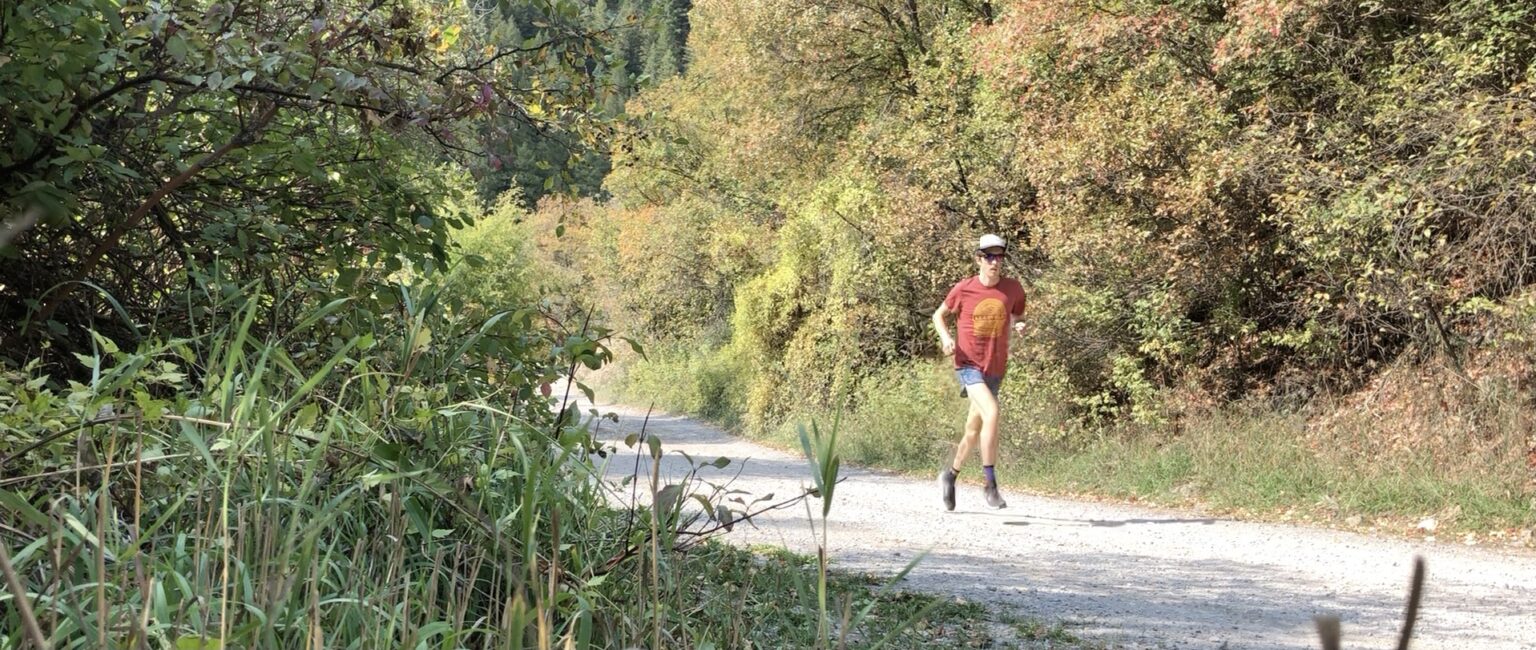
Even with my sizing struggles taken into consideration, the Terrex Two Ultra also feels just a bit too roomy / high-volume throughout for my liking — at least on technical terrain. I do like the Terrex Two Ultra’s fairly wide toe box — it offers more space for toe-splay than a shoe like the Hoka One One EVO Speedgoat, though it’s not quite as wide as the toe boxes on shoes from Altra and Topo. Unfortunately, that extra width / volume gets carried through to the midfoot and heel as well, which doesn’t work too well for my narrow / low-volume feet. There’s significantly more width and volume through the Terrex Two Ultra’s midfoot and heel than in just about any other shoe I’ve recently tested — including wider-fitting shoes like the Topo Mtn Racer 2, Inov-8 TrailFly Ultra G 300 Max, and Altra Timp 2.0. For my preferences at least, that gives the Terrex Two Ultra a fairly sloppy feel, particularly on off-camber and / or steep terrain.
With that said, it’s important to keep two things in mind regarding the Terrex Two Ultra’s fit. First, I have narrow feet with low arches, so if you have wider feet and / or higher arches, the Terrex Two Ultra might fit you very well (again, go try it on!). And second, I think at least some of that sloppiness stems from the fact that my pair of Terrex Two Ultra is a half size too big. The shoe is definitely built on a wider last overall, regardless of sizing, but I do think it’d feel slightly more secure if I sized down to an 11.
Weight
Both on paper and out on the trail, the adidas Terrex Two Ultra isn’t a particularly light shoe. Sure, it’s designed to prioritize cushion and comfort over minimum weight, but it’s still one of the heavier shoes in the mid-cushion trail shoe category. For reference, here’s how the Terrex Two Ultra compares to shoes with similar stack heights from a few other brands (all stated weights are based on a US Men’s size 9):
257 g / 9.1 oz — Hoka One One Torrent 2
272 g / 9.6 oz — Altra Timp 3
286 g / 10.1 oz — Topo Athletic Mtn Racer 2
292 g / 10.3 oz — Salomon Sense Ride 4
314 g / 11.1 oz — Brooks Cascadia 16
314 g / 11.1 oz — Saucony Peregrine 11
320 g / 11.3 oz — New Balance Fresh Foam Hierro v6
320 g / 11.3 oz — adidas Terrex Two Ultra
So yeah, the Terrex Two Ultra is kinda heavy. As you might recall from my other reviews, I generally don’t mind some extra weight as long as that extra weight is doing some serious work to make the shoe better in some other respect — and I think that’s partially true for the Terrex Two Ultra. It uses adidas’ TPU-based BOOST midsole material, which is generally heavier than a standard EVA midsole, but also provides pretty awesome cushioning (more on that in the “Midsole” section). I’m all for awesome cushioning, but the Terrex Two Ultra’s extra weight is also definitely noticeable out on trail — partially because of the shoe’s looser, less precise fit. That probably won’t be an issue if you prioritize cushion / comfort over weight, but if you’re looking for a lightweight race-day shoe, my advice would be to look elsewhere.
Upper
As I touched on in the intro, the Terrex Two Ultra uses adidas’ PRIMEKNIT upper, which incorporates yarn derived from recycled ocean plastic. That sounds pretty cool from an environmental perspective, but how does it perform? In my experience, the Terrex Two Ultra’s upper is extremely comfortable, but not the most secure / stable. The upper uses a stretchy sock-like construction, which feels great when I put on the shoe — the materials conform to my foot nicely, but also provide lots of stretch that totally alleviates any hot spots or rubbing in my experience. The PRIMEKNIT upper also breathes just as well as a traditional mesh upper, as far as I can tell.
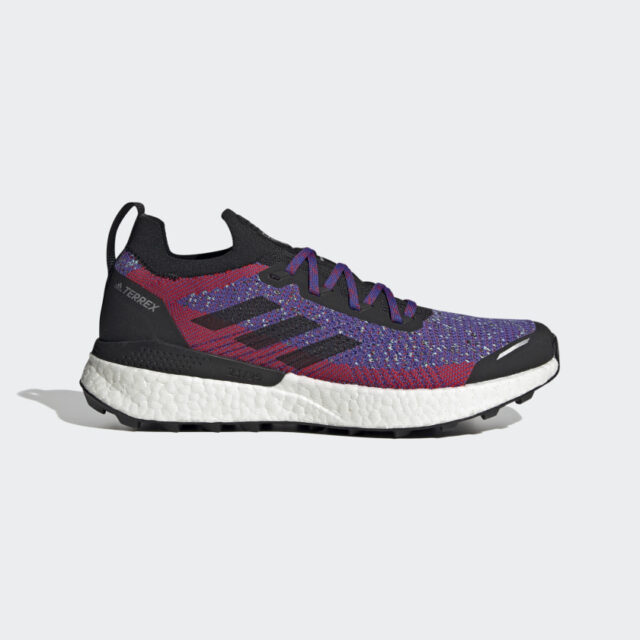
The flip side of that stretchy, compliant upper is that it doesn’t lock down very well, especially for my narrow / low-volume feet. There are some more rigid overlays in the midfoot, but I have a hard time getting the shoe to feel tight / secure enough. I don’t mind that roomier feel on non-technical terrain, but it makes the Terrex Two Ultra feel pretty unstable when the terrain gets rough.
Midsole
The Terrex Two Ultra’s midsole uses adidas’ TPU-based BOOST compound, which has a pretty strong following in the brand’s road lineup. A quick digression on midsole materials — most shoes use an EVA-based foam, but many brands have started incorporating TPU-based compounds in certain shoes in the last couple of years. Generally speaking, EVA-based foams are lighter and a bit firmer, while heavier TPU-based compounds feel softer but also provide excellent energy return — hence the “BOOST” label for adidas’ TPU midsoles.
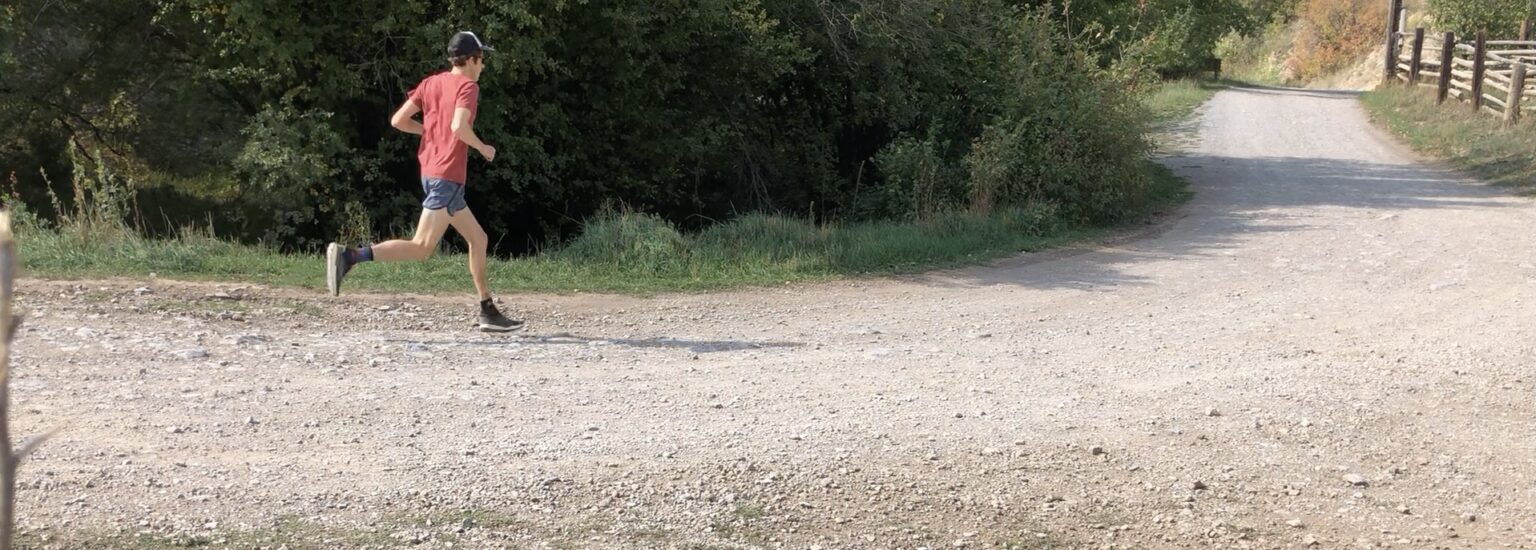
True to form, the Terrex Two Ultra’s midsole feels simultaneously soft and springy, which gives the shoe a very comfortable yet efficient feel on mellow terrain. It also makes the Terrex Two Ultra feel more cushioned than you might expect for a shoe with a fairly moderate 29 mm / 23 mm stack height. This shoe feels much more like the Hoka EVO Speedgoat than the Altra Timp, even though the Speedgoat has more cushioning (32 mm / 28 mm) than either the Timp or the Terrex Two Ultra. At the same time, I think the Terrex Two Ultra provides better energy return than lighter shoes like the Altra Timp or Topo Mtn Racer thanks to its BOOST midsole. Unfortunately, that doesn’t totally translate to an efficient ride overall because of the Terrex Two Ultra’s higher weight and looser fit. But from a cushioning perspective alone, I think the Terrex Two Ultra’s midsole really stands out from the competition.
Outsole
While the Terrex Two Ultra’s midsole has a lot going on, the outsole is relatively straightforward. Like all of adidas’ trail running shoes, the Terrex Two Ultra features a Continental Rubber outsole with a tread pattern inspired by Continental’s mountain bike tires. In the case of the Terrex Two Ultra, that translates into a series of fairly shallow, widely spaced rectangular lugs. Unfortunately, adidas doesn’t publish the relative stickiness / hardness of the outsole compounds on different shoes in their lineup, but the Terrex Two Ultra’s outsole feels a bit less sticky / grippy than the Terrex Speed Ultra’s outsole, in my opinion.
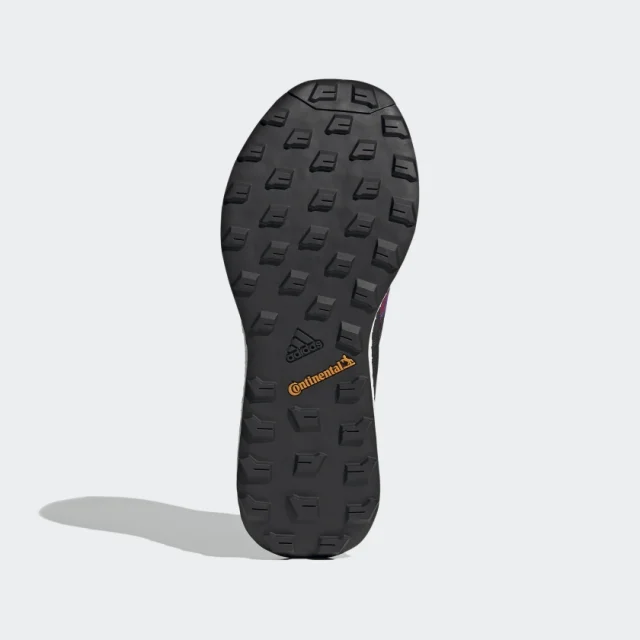
Overall, the Terrex Two Ultra’s outsole performs well on the fairly moderate terrain that the rest of the shoe also handles well. There’s plenty of traction for moderate trails and a little bit of mud / loose terrain, but the shoe definitely doesn’t have the traction of a shoe like the La Sportiva Cyklon on steep, loose, and / or muddy terrain. Still, for most trails, the Terrex Two’s outsole gets the job done.
On Trail
As you’ve probably picked up on by now, I think the Terrex Two Ultra is a solid shoe for runs on fairly mellow terrain where high speeds and minimal weight aren’t the top priorities. I’ve tested the Terrex Two Ultra on a variety of terrain and distances over my first 65 miles in the shoe, but I think its looser fit, moderate traction, and soft outsole only work well for my preferences in fairly specific settings.
For the type of running I usually do, that pretty much means I only pick the Terrex Two Ultra over other shoes in my larder for shorter, slower recovery runs. When I’m not at all worried about speed and I’m not going to be on anything remotely technical, the Terrex Two provides a much more comfortable ride than shoes like the Terrex Speed Ultra, Topo Mtn Racer 2, and Hoka EVO Speedgoat. The Terrex Two Ultra’s roomy fit and soft, springy cushioning feel great on short (an hour or less), mellow recovery runs — especially if my feet are a little beat up from a long mountain run the day before.
Of course, the flip side is that for the longer, more technical runs that make up the bulk of my running regimen, I almost always reach for other shoes over the Terrex Two Ultra. I do think that the Terrex Two Ultra is comfortable / cushioned enough for longer runs, but because my longer runs usually also include much more technical terrain, I generally prefer tighter-fitting, more precise shoes. The Terrex Two Ultra feels pretty sloppy and inefficient on steep, technical terrain because of its higher-volume fit and heavier midsole — especially compared to narrower shoes like the Terrex Speed Ultra or Hoka EVO Speedgoat.
With that said, most of my critiques of the Terrex Two Ultra are a matter of personal preference and running style. If I had wider feet and / or did more runs on non-technical terrain, I’d probably get along with the Terrex Two Ultra much better than I do. I think the Terrex Two Ultra would make a great shoe for longer runs on dirt roads and mellow trails, especially for runners who don’t like the narrower fits of shoes from Hoka or Salomon.
Durability
Obviously, I’ll have to put many more miles on the Terrex Two Ultra before I can draw any meaningful conclusions about its long-term durability, but so far everything seems to be holding up quite well. The outsole looks pretty much the same as it did out of the box, and the BOOST midsole hasn’t lost any of its spring after 65 miles of use. The PRIMEKNIT upper is also holding up well — there’s no sign of any premature fraying or wear, and I fully expect the Terrex Two Ultra to hold up for several hundred miles of use. If that changes down the road, I’ll be sure to come back and update this section.
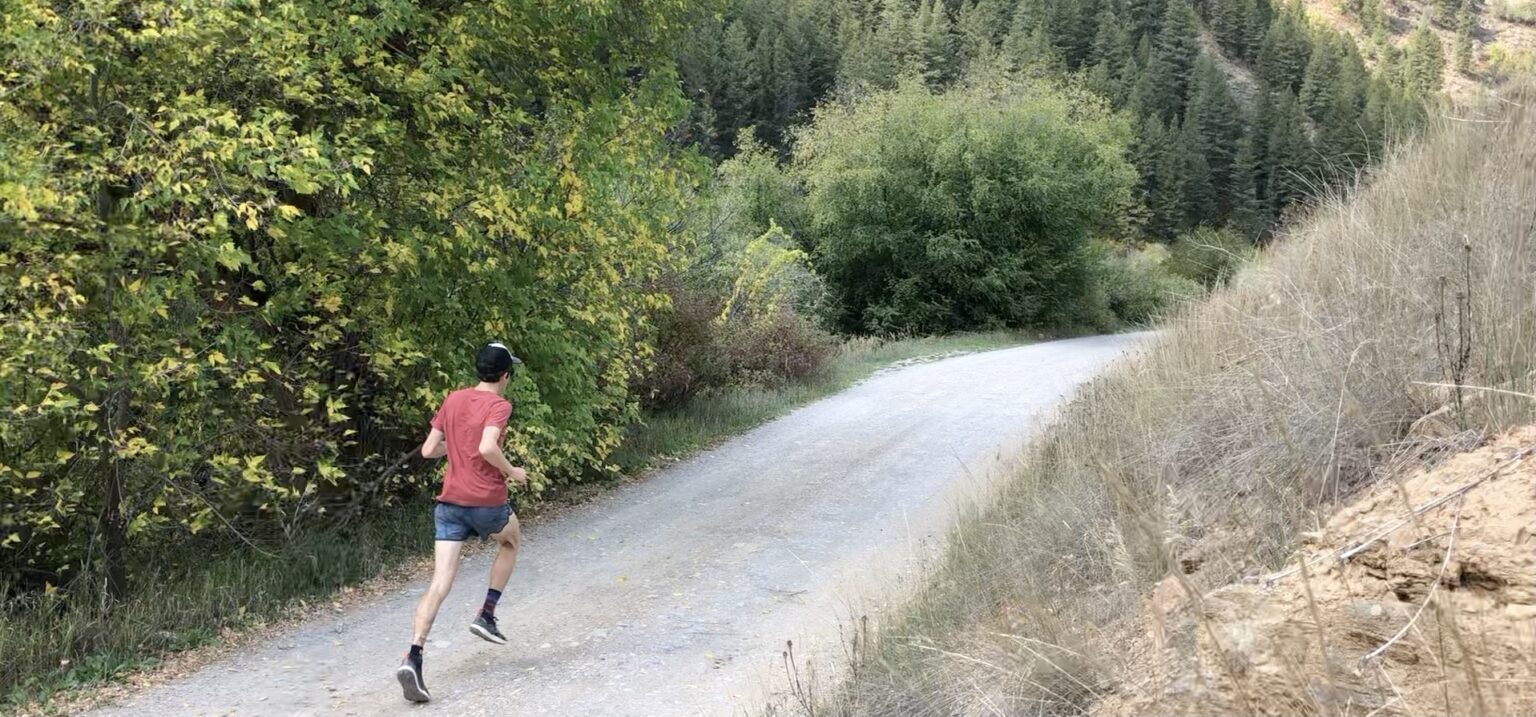
Who’s It For?
As I said earlier, I think the Terrex Two Ultra could be a great shoe for runners with wider, higher-volume feet and / or runners who don’t run lots of technical trails. The shoe’s stretchy, accommodating upper is certainly comfortable enough for long runs, and the shoe’s BOOST midsole feels like it provides much more cushion than other shoes with similar stack heights. With that said, I wouldn’t recommend the Terrex Two Ultra if you have narrow feet and / or run lots of steep, technical terrain. I’d also strongly recommend trying on the Terrex Two Ultra in person if at all possible to make sure you get the right size, since you’ll probably need to size down at least a half size from whatever you wear in shoes from other brands.
Bottom Line
While the adidas Terrex Two Ultra didn’t necessarily line up with my preferences very well, I think it could be a great shoe for the right person in the right setting. The shoe’s accommodating fit and soft, springy midsole make it a great recovery run shoe for my preferences, and could make it a great all-round shoe for runners who generally don’t spend as much time on super technical terrain. So if you like a wide, comfortable, soft shoe and generally stick to fairly moderate terrain, the Terrex Two Ultra could be an excellent option.


